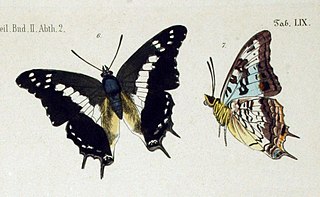The individual member states of the African Union (AU) coordinate foreign policy through this agency, in addition to conducting their own international relations on a state-by-state basis. The AU represents the interests of African peoples at large in intergovernmental organizations (IGO's); for instance, it is a permanent observer at the United Nations' General Assembly.
Amsacta is a genus of tiger moths in the family Erebidae erected by Francis Walker in 1855. The genus contains several species that need a review.
Teracotona is a genus of moths in the family Erebidae from the Afrotropics. The genus was erected by Arthur Gardiner Butler in 1878.

Eublemma is a genus of moths of the family Erebidae described by Jacob Hübner in 1829.

Pseudozarba is a genus of moths in the subfamily Eustrotiinae of the family Noctuidae. The genus was described by Warren in 1913.

Audea bipunctata is a species of moth in the family Erebidae. It is found in central and southern Africa (Democratic Republic of Congo, Kenya, Malawi, Mozambique, Sierra Leone, South Africa, Sudan, Tanzania and Zimbabwe.

Colotis celimene, the lilac tip or magenta tip, is a butterfly of the family Pieridae. The species was first described by Hippolyte Lucas in 1852. It is found in the Afrotropical realm.

Junonia terea, the soldier pansy or soldier commodore, is a butterfly of the family Nymphalidae. The species was first described by Dru Drury in 1773. It is found in the Afrotropical realm.

Papilio nireus, the green-banded swallowtail, narrow-banded blue swallowtail, or African blue-banded swallowtail, is a butterfly of the family Papilionidae. It is found in Sub-Saharan Africa.

Charaxes achaemenes, the bushveld emperor or bush charaxes, is a butterfly of the family Nymphalidae found across Africa.

Papilio phorcas, the apple-green swallowtail or green-banded swallowtail, is a butterfly of the family Papilionidae. It is found in Africa.

Spilosoma baxteri is a moth of the family Erebidae. It was described by Walter Rothschild in 1910. It is found in Kenya, Malawi and Tanzania.

Charaxes ansorgei is a butterfly in the family Nymphalidae. It is found in Sudan, the Democratic Republic of Congo, Uganda, Rwanda, Burundi, Kenya, Tanzania, Malawi and Zambia. The habitat consists of montane forest on altitudes between 2,000 and 3,000 meters. The larvae feed on Bersama abyssinica abyssinica, Bersama abyssinica englerana and Bersama paullinoides.

Charaxes pollux, the black-bordered charaxes, is a butterfly in the family Nymphalidae.

Charaxes dilutus is a butterfly in the family Nymphalidae. It is found in Uganda, Tanzania, Malawi, the Democratic Republic of the Congo, Zambia and Angola. The habitat consists of evergreen forests.

Charaxes baumanni, the little charaxes, is a butterfly in the family Nymphalidae. It is found in Sudan, Kenya, the Democratic Republic of the Congo, Uganda, Rwanda, Tanzania, Zambia, Malawi, Mozambique and Zimbabwe. The habitat consists of open forests and woodland.
Amsacta grammiphlebia is a moth of the family Erebidae. It was described by George Hampson in 1901. It is found in the Democratic Republic of the Congo, Malawi, Zambia and Zimbabwe.











